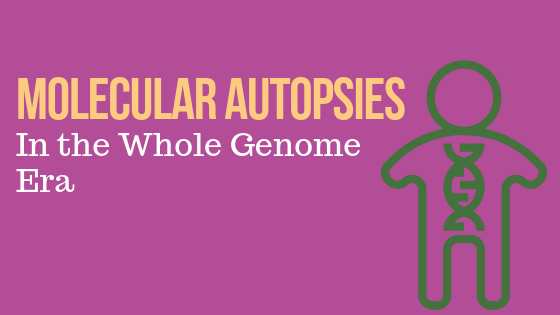Every year, nearly 8 million people die from sudden cardiac death, which is defined as the unexpected death of a seemingly healthy person due to malfunctions in the heart’s electrical system and loss of cardiac function. Although sudden cardiac death (SCD) is usually associated with mature adults, SCD claims thousands of young lives every year. In most cases, the cause of death can be determined by autopsy or toxicological analysis, but up to 30% of these premature deaths have no apparent cause, leaving medical examiners and family members of the young victims to wonder what happened.
In cases where traditional pathological examinations cannot provide insight into causation, medical examiners are increasingly turning to molecular autopsies to determine if there is an underlying genetic factor that contributed to a person’s death.
Written by: Terri Sundquist, Promega
Young SCD victims are much more likely to have inherited their cause of death than elderly victims, who often succumb to coronary artery disease. The genetic disorders linked to SCD are sorted into two main categories: cardiomyopathies—prominent structural abnormalities that would be visible during autopsy—and primary electrical diseases, which are usually caused by defects in transmembrane ion channels that regulate the flow of ions across the cell membrane and maintain the cardiac action potential and a regular heart rate. Defects in these ion channel often result in cardiac arrhythmias, which are detected by electrocardiography (ECG), but ECG is limited to living patients for obvious reasons. Many arrhythmias are asymptomatic and go undetected, explaining why many of these deaths are sudden and unexpected.
To date researchers have identified nearly 100 genes that are linked to SCD (reviewed in reference 1). The first report of using Molecular Biology techniques to explain a sudden cardiac death was in 1999, when Ackerman et al. used PCR to detect a mutation in exon 1 of the KVLQT1 gene and diagnose Inherited Long-QT Syndrome in a 19-year-old woman who died after a near drowning (2). Since then, scientists have developed several types of genetic tests to detect gene mutations linked to primary electrical disease and cardiomyopathies, ushering in the new term “molecular autopsy”.
These genetic tests fall into three categories: 1) analysis of panels of genes known to be linked to SCD, 2) whole exome sequencing (WES) and 3) whole genome sequencing (WGS). All three employ massively parallel sequencing, also known as next-generation sequencing, to detect gene mutations. Gene panels are the most common tool and the least complex and time-consuming, but analysis is limited to known SCD-related genes. Whole exome sequencing focuses on the protein-coding regions of DNA, which represents less than 2% of the total genome. By examining the entire exome, WES removes the bias inherent in analyzing panels of known genes. The technique is relatively cost effective and can detect approximately 85% of the known gene mutations linked to SCD. WES is a common research tool to identify new gene variants associated with inherited cardiomyopathies or primary electrical diseases.
Whole genome sequencing is the most complex of the three methods and can detect genetic mutations that the other two techniques cannot, including chromosomal rearrangements and mutations within noncoding DNA. During WGS, the entire genome is sequenced, and the resulting sequence is compared to a reference genome to generate a list of DNA variants. In theory, WGS can detect every DNA polymorphism in a person’s genome, increasing the chance that the causative gene mutation will be detected, but researchers are left to determine if such a genetic difference is relevant to the disease state. This makes interpretation difficult, especially in the context of a single death.
To help filter out irrelevant variants and simplify data interpretation, many medical centers and laboratories that perform molecular autopsies establish criteria for prioritizing these variants. For example, due to their disruptive nature, nonsense mutations, insertions and deletions, nonsynonymous substitutions and mutations that affect RNA splicing are labeled as good candidates for further study, as are mutations at highly conserved nucleotides. To weed out poor candidates, researchers often compare the genome of interest to other genomes in public or internal databases; variants found in genomes that are not associated with SCD are dropped from the list or given a much lower priority score.
Once the list of gene variants is generated and mutations are prioritized, researchers can perform computer simulations to try to predict the effect of a specific mutation on protein function. One such modeling tool is Mutation Taster (3). Based on these in silico analyses, scientists can rank the gene variants as pathogenic variants, likely pathogenic variants and variants of unknown significance.
As the cost of massively parallel sequencing decreases, WGS becomes a more feasible option to diagnose SCD, especially in cases where electrocardiography is not possible (i.e., postmortem diagnosis). Advances in sequencing technology and more complete lists of pathogenic gene variants may make unexplained SCD a thing of the past, providing an explanation, and perhaps more importantly closure, to families of SCD victims.
References
- Brion, M. et al. (2015) Massive parallel sequencing applied to the molecular autopsy in sudden cardiac death in the young. Forensic Sci. Int. Genet.http://dx.doi.org/10.1016/j.fsigen.2015.07.010.
- Ackerman, M.J. et al. (1999) Molecular diagnosis of the inherited long-QT syndrome in a woman who died after near-drowning. N. Engl. J. Med. 341, 1121–5.
- Schwarz, J.M. et al. (2014) MutationTaster2: Mutation prediction for the deep-sequencing age. Nat. Methods 11, 361–2.
Would you like to see more articles like this? Subscribe to the ISHI blog below!


